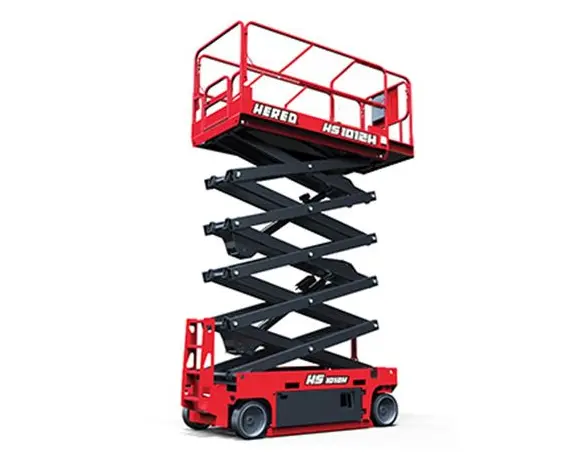How Does a Scissor Lift Work?
Scissor lifts rely on cross balance supports for vertical movement. Their method of raising and lowering depends on the powering system, which can be hydraulic, diesel, or electric. These versatile lifts are employed across various tasks, including building repairs and accessing high-placed warehouse items. While their functions are widely understood, understanding the inner workings of a scissor lift is crucial.
Explore our guide below to grasp the components of the lift, comprehend how its power options influence its lifting action, and discover the safety measures operators employ while using a scissor lift.
Parts of a Scissor Lift
To comprehend how a scissor lift operates, it's essential to familiarize yourself with its various components. Below, we delve into the fundamental parts of a typical scissor lift:
1. Platform: Available in diverse shapes, sizes, and densities depending on the model, the platform serves different purposes. Railed platforms are typically used for transporting individuals, whereas those without rails are designed for moving materials. This part is also referred to as the "lift table."
2. Base: The size of the base varies according to the model and acts as the lift's foundation. Constructed with sturdy metal, it includes tracks that guide rollers attached to the bottom of the scissor legs. These rollers, combined with solid base support, ensure smooth ascent and descent.
3. Scissor Legs: Extending from the base to the platform, these legs are responsible for raising the platform by contracting and lowering it by expanding. They are arranged in a pantograph or criss-cross pattern.
4. Cylinder(s): Scissor lifts are equipped with one to four cylinders, each type containing different substances depending on the lift variety. For instance, hydraulic scissor lifts have cylinders filled with hydraulic fluid, while another type employs pneumatic pumps filled with compressed air.
5. Power Source: The power source can be a self-contained motor or a remote power pack. Scissor lifts employ various power sources (further details on power sources will be discussed later).
6. Down Valve: This valve regulates the flow of compressed air or hydraulic fluid, enabling it to return to its original container. Its purpose is to prevent rapid descent, activating only when prompted by the power source.
7. Flow Control Valve: Responsible for managing the speed of the platform's descent, this valve regulates the rate at which fluid or compressed air exits the cylinder.
Understanding these key components is crucial in comprehending the functionality and operation of a scissor lift.
How a Scissor Lift Works
The way a scissor lift works depend on its power source, but the resulting movement is the same.
1. Activation of Power Source: Upon activation, the power source initiates the filling of the cylinder(s) with either hydraulic fluid or compressed air.
2. Pressure Transfer: The hydraulic fluid or compressed air moves from one section to another within the system.
3. Outward Cylinder Movement: This transfer of fluid or air causes the cylinder to extend outwards, prompting the scissor legs to spread apart.
4. Platform Elevation: As a result of the outward movement of the cylinder and leg expansion, the platform ascends.
5. Descent Process: To lower the scissor lift, the operator releases the pressure or fluid within the system, reversing the earlier steps to initiate the descent.
The descent speed is contingent upon the scissor lift's power and the weight the platform bears. When dealing with heavier loads, a more potent scissor lift is advisable. For instance, heavier loads make it challenging for the engine to exert enough force on the liquid or air to expand the cylinder outward.
How Scissor Lifts are Powered
Scissor lifts come in various types, primarily distinguished by their power sources. Below are the different methods through which scissor lifts are powered:
1. Hydraulics: Hydraulic scissor lifts utilize hydraulic fluid within their cylinders to facilitate their lifting function. They're user-friendly and typically require minimal operator training. Ideal for uncomplicated projects prioritizing neither speed nor horsepower.
2. Pneumatic: Pneumatic scissor lifts utilize air pressure to elevate and lower the platform. They offer a sustainable option by producing no emissions or fumes but provide less power. Suited for smaller projects and indoor usage.
3. Diesel: Diesel-powered scissor lifts operate using diesel fuel. They boast substantial power, capable of carrying heavier loads and offering larger platforms. However, they're more suitable for outdoor sites or well-ventilated areas due to emissions and loud noise.
4. Electric: Electric scissor lifts operate silently with powered mechanisms. They are quiet, emission-free, and usually less bulky than higher-powered models. Well-suited for use in confined spaces.
Ensuring Safety for Operators on Scissor Lifts
Operating a scissor lift at significant heights involves inherent safety risks for operators. Here are several measures to prioritize safety while using a scissor lift:
1. Pre-Operation Safety Check: Before operation, conduct a thorough check to ensure all components, including brakes and emergency stop buttons, are functioning correctly.
2. Crew Training and Familiarity: Ensure all crew members have undergone proper training and are familiar with the specific scissor lift being used on that day.
3. Clear Surrounding Area: Eliminate potential safety hazards from the surrounding area to create a safer working environment.
Scissor lifts serve as reliable heavy equipment choices for completing tasks at elevated locations safely and effectively. Explore our extensive range to find the ideal option that suits your project requirements best.






